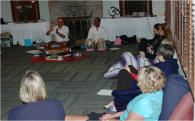Yoga and Breathing
The physical practice of yoga involves the coordination of the postures with your breathing. The first thing we do when we enter this world is breathe, and it’s the last thing we’ll do as we leave. Breathing has an important role in the life of a human being. It provides the body with oxygen and takes out carbon dioxide.
If you sit in a park and bring awareness to your breathing, you will notice a remarkable connection between yourself and our environment. What you breathe out is what the tree breathes in. What you breathe in is what the tree breathes out. It is the oxygen-carbon dioxide interchange.
Breathing also provides the human system with vital energy, which is known as prana, chi or ki. The human breath is the link between humanity and divinity. It is a process we sometimes take for granted, but we can change how we feel by changing the way we breathe. On the mat, we should let the breath fuel our practice.
In yoga, we treat the act of breathing with respect and reverence. I like to reframe the act of breathing. In teaching yoga, I would often say “Invite the breath into your body. Allow it to do its work. Now, gently escort the breath out”. In this way, we do not struggle with the breath but rather work with the intelligence of its flow.
Here is an exercise you can do at home to practice yogic breathing:
Exercise
Lie down on your back and relax.
Close your eyes.
Keep your hands and legs stretched out.
Abdominal Breathing
As you observe your natural breath, you notice that when you inhale the abdomen rises. As you exhale, it falls. Now let the abdomen rise to its limit. On exhalation let it fall completely. Keep the chest still during this process – and move the abdomen. Continue with this for ten breaths and then rest.
Chest Breathing
This is also called thoracic breathing. Feel your normal breath, focusing your attention on the chest. You will notice the chest moving slightly up at inhalation, and down with exhalation. Now on inhalation expand and lift the rib cage, filling the lungs completely. On exhalation, let the lungs collapse fully. Keep the abdomen still and move only the chest. Do this for ten breaths and then rest.
Yogic Breathing
This combines the above 2 types of breathing in the following way:
Inhale by filling the abdomen and then CONTINUE to inhale as you expand and fill the chest. Then exhale first from the chest. As it empties and falls, CONTINUE to exhale from the abdomen as it draws inwards. This is one round of a yogic breath. Repeat this for 20 rounds. Remember the pattern…. Inhaling – abdomen then chest: Exhaling – chest then abdomen. Initially you may experience some unevenness in the yogic breathing process. This is expected. Try to breathe smoothly as a continuous wave and soon you will achieve a smooth flow.

Nand lecturing at the Yoga Teachers Training Program, Kentucky USA

